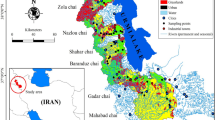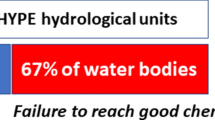Abstract
Widespread distribution of atmospherically mobilized organochlorine pollutants (OCPs) has been documented throughout the Arctic. A fraction of these OCPs have become entrained in glacial ice, and during melting, they can be released into downstream reservoirs. Though this remobilization is known, an assessment of risk from glacial meltwater to collocated human communities in the Arctic, including Alaska, had not been accomplished. Here, we use a screening-level risk assessment model for glacial watersheds, based on US Environmental Protection Agency (EPA) methodology, which we apply to the glaciated Jarvis Creek watershed of interior Alaska. Model results indicate that even with low levels of OCPs in glacial meltwater, high fish consumption by subsistence communities in the area increases the risk of cancer and hazard impacts above acceptable limits. Though this model is specific to one watershed, our results imply that further investigation of an increasing OCP signal in glacial meltwater and fish throughout the North American Arctic is warranted.
This is a preview of subscription content, access via your institution
Access options
Subscribe to this journal
Receive 6 print issues and online access
$259.00 per year
only $43.17 per issue
Buy this article
- Purchase on Springer Link
- Instant access to full article PDF
Prices may be subject to local taxes which are calculated during checkout

Similar content being viewed by others
References
Simonich SL, Hites RA. Global distribution of persistent organic compounds. Science. 1995;269:1851–3.
Shen L, Wania F, Lei YD, Teixeira C, Muir DCG, Bidleman TF. Atmospheric distribution and long-range transport behavior of organochlorine pesticides in North America. Environ Sci Technol. 2005;39:409–20.
Jiménez JC, Dachs J, Eisenreich SJ. Atmos Depos POPs [Internet]. 2015;67:295–322. http://linkinghub.elsevier.com/retrieve/pii/B9780444632999000089
Steinlin C, Bogdal C, Lüthi MP, Pavlova PA, Schwikowski, Margit Zennegg M, Schmid P, et al. A temperate alpine glacier as a reservoir of polychlorinated biphenyls: model results of incorporation, transport, and release. Environ Sci Technol. 2016;50:5572–9.
Steinlin C, Bogdal C, Pavlova PA, Schwikowski M, Lüthi MP, Scheringer M, et al. Polychlorinated biphenyls in a temperate alpine glacier: 2. Model results of chemical fate processes. Environ Sci Technol. 2015;49:14092–100.
Lei YD, Wania F. Is rain or snow a more efficient scavenger of organic chemicals? Atmos Environ. 2004;38:3557–71. http://linkinghub.elsevier.com/retrieve/pii/S1352231004003243
Bogdal C, Schmid P, Zennegg M, Anselmetti FS, Scheringer M, Hungerbühler K. Blast from the past: melting glaciers as a relevant source for persistent organic pollutants. Environ Sci Technol. 2009;43:8173–7. http://www.ncbi.nlm.nih.gov/pubmed/19924940.
Blais JM, Schindler DW, Muir DCG, Sharp M, Donald D, Lafrenière M, et al. Melting glaciers: a major source of persistent organochlorines to subalpine Bow Lake in Banff National Park, Canada. Ambio. 2001;30:410–5. http://www.jstor.org/stable/4315176%5Cnpapers3://publication/uuid/F969C516-6043-45CA-861C-C85E312B9BBB.
Miner KR, Bogdal C, Pavlova PA, Steinlin C, Kreutz KJ. Quantitative screening level assessment of human risk from PCB in glacial meltwater: Silvretta Glacier, Swiss Alps. Ecotoxicol Environ Saf. 2018;166:251–8. https://doi.org/10.1016/j.ecoenv.2018.09.066
Quadroni S, Bettinetti R. Health risk assessment for the consumption of fresh and preserved fish (Alosa agone) from Lago di Como (Northern Italy). Environ Res. 2017;156:571–8. http://linkinghub.elsevier.com/retrieve/pii/S0013935117300324.
Kwok KY, Yamazaki E, Yamashita N, Taniyasu S, Murphy MB, Horii Y, et al. Transport of perfluoroalkyl substances (PFAS) from an arctic glacier to downstream locations: implications for sources. Sci Total Environ. 2013;447:46–55. http://www.sciencedirect.com/science/article/pii/S0048969712013915.
Helm Pa, Diamond ML, Semkin R, Strachan WMJ, Teixeira C, Gregor D. A mass balance model describing multiyear fate of organochlorine compounds in a high Arctic lake. Environ Sci Technol. 2002;36:996–1003. http://www.ncbi.nlm.nih.gov/pubmed/11924545.
Hauptmann AL, Sicheritz-Pontén T, Cameron KA, Bælum J, Plichta DR, Dalgaard M, et al. Contamination of the Arctic reflected in microbial metagenomes from the Greenland ice sheet. Environ Res Lett. 2017;12:074019. http://stacks.iop.org/1748-9326/12/i=7/a=074019?key=crossref.695b0db5b9970f0d1efdfe5634da1736
Friedman CL, Selin NE. PCBs in the Arctic atmosphere: determining important driving forces using a global atmospheric transport model. Atmos Chem Phys. 2016;16:3433–48. http://www.atmos-chem-phys-discuss.net/15/30857/2015/.
Garmash O, Hermanson MH, Isaksson E, Schwikowski M, Divine D, Teixeira C, et al. Deposition history of polychlorinated biphenyls to the lomonosovfonna glacier, Svalbard: a 209 congener analysis. Environ Sci Technol. 2013;47:12064–72.
Hermanson MH, Isaksson E, Teixeira C, Muir DCG, Compher KM, Li YF, et al. Current-use and legacy pesticide history in the Austfonna ice cap, Svalbard, Norway. Environ Sci Technol. 2005;39:8163–9.
Vizcaino E, Grimalt JO, Fernandez-Somoano A, Tardon A. Transport of persistent organic pollutants across the human placenta. Environ Int. 2014;65:107–15. https://doi.org/10.1016/j.envint.2014.01.004.
Rubin CH, Lanier A, Kieszak S, Brock JW, Koller KR, Strosnider H, et al. Breast cancer among Alaska Native women potentially exposed to environmental organochlorine chemicals. Int J Circumpolar Health. 2006;65:18–27.
Lee Y-M, Kim K-S, Kim S-A, Hong N-S, Lee S-J, Lee D-H. Prospective associations between persistent organic pollutants and metabolic syndrome: a nested case-control study. Sci Total Environ. 2014;496:219–25. http://www.ncbi.nlm.nih.gov/pubmed/25089684.
Ruzzin J. Public health concern behind the exposure to persistent organic pollutants and the risk of metabolic diseases. BMC Public Health 2012;12:298 http://www.biomedcentral.com/1471-2458/12/298.
Birnbaum LS. When environmental chemicals act like uncontrolled medicine. Trends Endocrinol Metab . 2013;24:321–3. https://doi.org/10.1016/j.tem.2012.12.005.
Gauthier MS, Rabasa-Lhoret R, Prud’homme D, Karelis AD, Geng D, Van Bavel B, et al. The metabolically healthy but obese phenotype is associated with lower plasma levels of persistent organic pollutants as compared to the metabolically abnormal obese phenotype. J Clin Endocrinol Metab. 2014;99:1061–6.
Miner KR, Campbell S, Gerbi C, Liljedahl A, Anderson T, Perkins BL, et al. Organochlorine pollutants within a polythermal glacier in the Interior Eastern Alaska Range. Water. 2018;10:1–14., 1157; https://doi.org/10.3390/w10091157
Liljedahl AK, Gädeke A, O’Neel S, Gatesman TA, Douglas TA. Glacierized headwater streams as aquifer recharge corridors, subarctic Alaska. Geophys Res Lett. 2017;6876–85. http://doi.wiley.com/10.1002/2017GL073834.
Ballew C, Ross A, Wells RS, Hiratsuka V. Final report on the Alaska traditional diet survey. Alaska Native Health Board and Alaska Native Epidemiology Center. Fairbanks; 2004.
Flowers GE, Clarke GKC. A multicomponent coupled model of glacier hydrology 2. Application to Trapridge Glacier, Yukon, Canada. J Geophys Res. 2002;107:2288. http://doi.wiley.com/10.1029/2001JB001124
Gatesman TA. Glacier contribution to lowland streamflow. University of Alaska, Fairbanks; 2017.
Zemp M, Frey H, Gärtner-Roer I, Nussbaumer SU, Hoelzle M, Paul F, et al. Historically unprecedented global glacier decline in the early 21st century. J Glaciol. 2015;61:745–62.
Fall JA, Brenner AR, Evans SS, Holen D, Hutchinson-Scarbrough L, Jones B, et al. Alaska subsistence and personal use salmon fisheries 2011 annual report. Technical Paper No. 387. 2013.
Bettinetti R, Quadroni S, Boggio E, Galassi S. Recent DDT and PCB contamination in the sediment and biota of the Como Bay (Lake Como, Italy). Sci Total Environ. 2016;542:404–10. http://linkinghub.elsevier.com/retrieve/pii/S0048969715309153.
(EPA) USEPA. Guidelines for Exposure Assessment [Internet]. Risk Assessment Forum. 1999;57: http://www.epa.gov/raf/publications/guidelines-for-exposure-assessment.htm
(EPA) USEPA. National Bioaccumulation Factors, Supplemental Information. 2015;1:1–18.
Hamade AK, Consumption ASAC for F. Fish consumption advice for alaskans a risk management strategy to optimize the public’s health. State of Alaska; 2014.
Epidemiology S of A. 2014 Updated fish consumption advice for alaskans. Anchorage, Alaska; 2014.
(EPA) USEPA. Development of national bioaccumulation factors: supplemental information for EPA’s 2015 Human Health Criteria Update Office of Science and Technology. 2016.
Office of Environmental Health Hazard Assessment CS. Appendix I Fish Bioaccumulation Factors. 2012.
Mackay D, Patterson S. Fugacity models. 1990.
Mackay D. Multimedia environmental models. CRC Press. 2001;2001:272.
(EPA) USEPA. Integrated Risk Information Systems [Internet]. Accessed July 20, 2002. https://www.epa.gov/iris
(EPA) USEPA. Human Health Risk Assessment Protocol: Appendix A-1. 2005.
(EPA) USEPA. Risk assessment guidance for superfund (RAGS): Step 3, Quantification of Exposure. 2001.
Phillips LJ, Moya J. Exposure factors resources: contrasting EPA’s Exposure Factors Handbook with international sources. J Expo Sci Environ. 2013;24:233–43. http://www.ncbi.nlm.nih.gov/pubmed/23611905.
(EPA) USEPA. Risk Assessment Guidance for Superfund (RAGS) Volume III—Part A: process for Conducting Probabilistic Risk Assessment, Appendix B [Internet]. Vol. III, Office of Emergency and Remedial Response U.S. Environmental Protection Agency. 2001. http://www.epa.gov/sites/production/files/2015-09/documents/rags3adt_complete.pdf
(EPA) USEPA, Studies; B on ES and TD on E and L, National Research Council. Science and Decisions [Internet]. National Academies Press; 2009. http://www.nap.edu/catalog/12209
Frey HC Quantitative Analysis of Uncertainty and Variability in Environmental Policy Making [Internet]. AAAS/EPA Environmental Science and Engineering. Pittsburgh, PA; 1992. http://www4.ncsu.edu/~frey/reports/frey_92.pdf
Bogen KT, Does EPA. Underestimate cancer risks by ignoring susceptibility differences? Risk Anal. 2014;34:1780–4.
Finkel AM. EPA underestimates, oversimplifies, miscommunicates, and mismanages cancer risks by ignoring human susceptibility. Risk Anal. 2014;34:1785–94.
Arnot Ja, Gobas FA. A review of bioconcentration factor (BCF) and bioaccumulation factor (BAF) assessments for organic chemicals in aquatic organisms. Environ Rev. 2006;14:257–97.
Mueller K, Matz A. Organochlorine concentrations in Burbot (Lota lota) Livers from Fairbanks Alaska, and Kanuti, Tetlin and Yukon Flats National Wildlife Refuges, Alaska, 1998. Fairbanks; 2000.
Conservation AD of E. Alaska Department of Environmental Conservation Office of the State Veterinarian Fish Monitoring Program Organochlorine Pesticides in Alaska’s Fishes. Anchorage, AK; 2017.
Lance S. Organochlorine Pesticides in Alaska’s Fishes, Fish Monitoring Program. Anchorage, AK; 2017.
Bizzotto EC, Villa S, Vighi M. POP bioaccumulation in macroinvertebrates of alpine freshwater systems. Environ Pollut. 2009;157:3192–8. http://www.sciencedirect.com/science/article/pii/S0269749109002978.
Ferrario C, Finizio A, Villa S. Legacy and emerging contaminants in meltwater of three Alpine glaciers. Sci Total Environ. 2017;574:350–7. http://linkinghub.elsevier.com/retrieve/pii/S0048969716319866.
Pavlova PA, Zennegg M, Anselmetti FS, Schmid P, Bogdal C, Steinlin C. et al. Release of PCBs from Silvretta glacier (Switzerland) investigated in lake sediments and meltwater. Environ Sci Pollut Res. 2016;23:10308–16. https://doi.org/10.1007/s11356-015-5854-z.
Dewailly E. Canadian Inuit and the Arctic Dilemma. Oceanography. 2006;19:88–9. http://www.tos.org/oceanography/issues/issue_archive/issue_pdfs/19_2/19.2_cs_dewailly.pdf.
Dewailly E, Nantel A, Weber J-P, Meyer F. High levels of PCBs in breast milk of inuit women from arctic quebec. Bull Environ Contam Toxicol. 1989;43:641–6.
Schmid P, Bogdal C, Bluthgen N, Anselmetti FS, Zwyssig A, Hungerbuhler K. The missing piece: sediment records in remote mountain lakes confirm glaciers being secondary sources of persistent organic pollutants. Environ Sci Technol. 2011;45:203–8.
Bogdal C, Schmid P, Kohler M, Müller CE, Iozza S, Bucheli TD, et al. Sediment record and atmospheric deposition of brominated flame retardants and organochlorine compounds in Lake Thun, Switzerland: lessons from the past and evaluation of the present. Environ Sci Technol. 2008;42:6817–22.
Programme AM and A. Arctic Pollution Status. 2009.
Acknowledgements
The authors would like to thank the team that contributed immeasurably to this work, including Glenn Rice from the EPA, who provided valuable guidance and feedback during the entire process. Orville Huntington the Wildlife and Parks Director for the Tanana Chiefs Conference provided important insight and guidance. We thank the field team in Alaska including CRREL and Tom Douglas, Ice Drilling and Design Operations, Tiffany Gatesman, Robert Hawley’s group at Dartmouth and Christopher Gerbi’s group at University of Maine. KR Miner was supported by the Switzer Foundation, SMART Scholarship and NSF grant DGE- 1144423.
Author information
Authors and Affiliations
Corresponding author
Ethics declarations
Conflict of interest
The authors declare that they have no conflict of interest.
Electronic supplementary material
Rights and permissions
About this article
Cite this article
Miner, K.R., Kreutz, K.J., Jain, S. et al. A screening-level approach to quantifying risk from glacial release of organochlorine pollutants in the Alaskan Arctic. J Expo Sci Environ Epidemiol 29, 293–301 (2019). https://doi.org/10.1038/s41370-018-0100-7
Received:
Revised:
Accepted:
Published:
Issue Date:
DOI: https://doi.org/10.1038/s41370-018-0100-7
Keywords
This article is cited by
-
Glacier foreland insect uptake synthetic compounds: an emerging environmental concern
Environmental Science and Pollution Research (2023)
-
Emergent biogeochemical risks from Arctic permafrost degradation
Nature Climate Change (2021)



